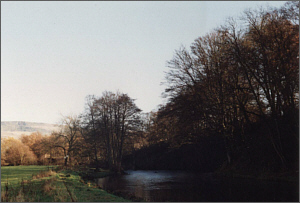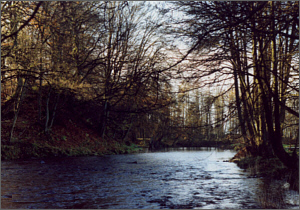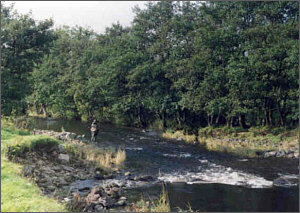Scottish Fishing Days and Nights
This is a fishing diary of days
and nights spent chasing trout, salmon and sea trout on rivers
and lochs throughout Scotland. From the mid nineteen eighties, I
kept a fairly regular, if simple, fishing diary, or log,
recording my fishing experiences, mainly of fly fishing for
trout, salmon and, in particular, sea trout. My main interest
has always been in river night fishing for sea trout, through
the short summer nights - fishing in the dark, so to speak,
sometimes very much so! Almost all my fishing has been done on
club and association waters, for which membership and permits are
generally available. In the hope that visitors to this
website might find some interest in my fishing exploits, I will
transcribe the contents of my diaries here beginning in the year
1985. The entries for each year will be archived and accessible
from the links above.
I first fished the River Endrick for sea trout in 1983,
my first outing on the river being recorded in the article entitled
Endrick Sea Trout. Having had a taste of
what this little Loch Lomond tributary could offer, I joined the Loch
Lomond
Angling Improvement Association the following year. This gave me access to
several miles of fishing on the River Leven, the whole of Loch Lomond and, most
importantly, to the larger part of the River Endrick, with its potentially
fabulous sea trout fishing. I had fished the Association water on the Endrick
for a season when I determined to keep a diary of my fishing. The early
entries were rather sketchy and, at times, incomplete but, as the habit
became established, so the detail became more comprehensive. I kept the
dairy at the shop and it soon became a routine matter to enter the
details of the previous day's or night's fishing while events were fresh
in my mind, between bouts of nodding off to sleep having got to bed at 5
or 6 am after a long night session on the Dam!
1984, my first year as an association member, was more
exploratory than productive. I sought the solitude of the less popular pools, in
the vain expectation of success. Only later, after becoming better acquainted
with the river, did I realise that there were very few pools which were
consistently productive. Consequently, in my first year, despite many nocturnal
hours by the river, there was little to record. I tried a variety of pools in
the many miles of fishing between Fintry and Gartness and had very limited
success. Indeed, catches were registered from only three pools. The Wheel, where
I fished most often, yielded three fish, the Cement Wall at Gartness, two and
Coolies Lynn, one. All fish were in the two to three pound range and all were
taken, at night, during the months of August and September, on fly and maggot
fished on a floating line. I had merely scratched the surface.
1985
During 1985, my second year as an Association member, I
continued to explore the river, not in any really constructive or organised way,
finding new pools, where the odd fish might be caught on favourable nights. I
was intent on exploring the river on my own, seeking out the quieter, less
popular pools and avoiding the busier pools, clearly marked by a number of cars
parked by the roadside on favourable nights. But the less popular pools on
association water are less popular for a good reason.... they are generally less
productive. I did catch a few fish but my success was modest in comparison to
what might be achieved on the best night pools, and I had many a blank night.
Trial and error, however, along with information gained from
customers and riverside conversation with fellow association
members, eventually focussed my attention on the better known
pools, such as Netherton, Coolies Lynn, The Oak Tree, The
Meetings Lynn and Drumtian. My diary shows that, in early July,
I had two sea trout of 1 1/4 lbs each at Netherton, taken just
after dark on a floating line with the river above summer level
but dropping. The successful pattern was a Mallard and Claret,
size eight, with two or three maggots on the bend of the hook. I
should say at this point that the night fishing on the Endrick
was mainly done with maggots attached to the fly. The main
reason for this was that the main sea trout pools, at summer
level, had very little flow. Much of the fishing was done on
very slow, almost dead, water, where it was difficult to give
life to a fly. I gave the conventional fly, without maggots, a
fair go. I even heard of fishers having some success with it but
I cannot recall, in ten years of fishing on the Endrick, having
caught a sea trout in the hours of darkness with a bare fly.
My diary of 1985 also records the following
successes:
Mid July - Drumtian - Afternoon ( 1
grilse 4.5 lbs)
Water falling and clearing nicely after
a small summer spate. Probably now at an ideal height for fly
but I had chosen to spin, which was permitted below Ballochruin
Bridge. After fishing down from the wooden bridge at Drumtian
with no result, I found one or two sea trout in the Red Braes
pool willing to follow my spinner. Unconvinced, they turned away
at the last moment. Encouraged, I continued down the pool and,
in the tail, just as the spoon left the far bank, I had a solid
take. After an anxious few minutes, I dragged the fish, rather
unceremoniously, on to the sandy bank. Four and a half pounds.
My first grilse.
Mid July - Drumtian - 11 pm to 1 am (
1 sea trout, 3 lbs)
Encouraged by my success with the
spinning rod, I soon returned to Drumtian. The water was fairly
high and coloured ( for night fishing) when I arrived at 11 pm
but was falling and clearing. Fishing a small Sweeney Todd with
a few maggots, I hooked, and succeeded in landing, a sea trout
of three pounds near my own bank in two feet of water.
Late July - Oak Tree - 11 pm
(sea trout 1 1/2 pounds)
In the tail of the pool above the Oak
Tree, just below where the burn runs in on the far bank, fishing
a Mallard and Claret with maggots and a neutral line, a
Masterline DT7, I hooked the only fish of the night, a nice wee
fish of 1 1/2 pounds.
August 19th - Coolies Lynn - 7.30 am
( sea trout 5 lbs 6 ozs)
A sunny Saturday morning with the sun
shining directly downstream. River fairly high after rain. I was
alone, fishing two flies, a size eight low water Curry's shrimp
and a Silver Blue, on a neutral line on a Sharpes 9.5 foot cane
rod. I had already lost one fish and had an offer from another,
just where the pool widens below the burn. Below me, a running
fish showed twice on its way up the pool. I timed my cast to
intercept it, just as the sun disappeared behind a cloud. To my
surprise, it took me. After a strong fight on the light rod, I
managed to net a lovely sea trout of 5 lbs 6 ozs.
August 26th - Drumtian - 10 pm to 1
am (sea trout 1 1/2 pounds)
River low and clear but still dropping.
Fish showing in the pool. Also busy with fishers. At 11 pm, I
caught my only sea trout of the night, immediately above the
overhanging tree, on my own version of a Dark Mackerel, with
maggots. A 5 lb was fish taken near the tail by dubious method.
August 25th - Coolies - 11 pm to 1 am
(sea trout 3 lbs 13 ozs)
River clear and fairly low. Very dark,
cloudy, windy with rain threatening. By 12.15 am, all other
fishers had gone, nothing caught. Just then, using a Dark
Mackerel, I hooked the only sea trout of the night, although I
did catch two brown trout of 1 lb and half a pound.
More and more often though, as the
season progressed, the name "Cowden Mill Dam" would crop up. The
dam, as it was referred to, had been built by association
members in the nineteen sixties, creating a holding pool of
around a hundred yards in length and twenty yards wide, with a
maximum depth of perhaps ten feet at the lower end near the dam.
Enclosed by trees on both sides, it provided sanctuary for the
shoals of large sea trout which, every year, made their way up
from Loch Lomond. But it was not until the late summer of 1985
that I was to fish "the Dam" for the first time. Prior to 1985,
although the association had access to both banks, it was only
ever fished from the left bank. Throughout the short season,
often not properly underway until August, the regulars would
assemble at the damside and while away the time in fishing talk
until the fall of darkness. One by one, in order of arrival,
they would then wade slowly and quietly down the edge of the
pool, pausing only to unhook a fish. Fantastic catches were made
in those days, through the sixties, seventies and even into the
eighties, though with less regularity than in the old days.
In September 1985, due to a disagreement
between the Association and the riparian
owner, we lost the Claylands fishing, comprising the left bank
of the Dam along with about two miles of good water immediately
downstream. A heavy blow, which would result in the loss of many
members, prompt a re-examination of the running of the
association and ultimately rock its very foundations. To
allow new access to the Dam, the trees on the right bank were
immediately cleared and fishing continued more or less as
before. The clearing of the trees seemed to have little effect
on the fish and, fortunately, the new owners of the lease on the
left bank rarely fished at night. They did, however, fish during
the day in high water and, unlike the association members, did
not restrict themselves to fly fishing. Understandably, this led
to some ill feeling and tempers would flare from time to time.
It was, in fact, on the first night
after the clearing of the right bank that I first fished the
Dam. I recall it well. Half a dozen members had gathered to
sample the "new" fishing. It was not going to be easy, as the
branches from the felled trees and bushes littered the
riverbank, both in and out of the water. All we could do was
choose a gap in the debris, clear a space as best we could and
get on with it, fishing from the one spot. The river was falling
and clearing nicely after a small spate and, as I recall, I
managed to land two nice fish, of one and a half and three
pounds. Not at all bad under the circumstances. For close on a
decade, I was to become one of the regulars on the Dam. My diary
records the next few weeks as follows:
That September was fantastic. I would
fish usually four nights a week, sometimes arriving early to
avoid the inevitable queue of fishers, or perhaps arriving at 11
or 12, by which time the queue had hopefully diminished. Either
way, I would fish for at least five hours. One "run" down the
pool would take 2 to 3 hours, fishing the fly and maggot as
slowly as possible down the length of the pool. The dam was
fishable on most nights, the exception being when it was high
and coloured after a late summer spate. If the river was highish,
but clear with a fairly good flow, I would fish the sink tip,
two size eight flies with perhaps 6 to 8 maggots. In low water,
it might be necessary to fish a single size 10 fly on a short
leader with only two or three maggots, to avoid snagging on the
riverbed. I caught my share of fish. One Monday morning, i.e. 12
midnight till dawn, using a sink tip line and long shank size
eight flies loaded with maggots, I caught seven sea trout for 26
lbs. The following night the river had dropped back to normal
level and I had nine sea trout for 27 lbs on the floating
line..... needless to say, my best two consecutive nights ever!
But there were many other good, though less spectacular, nights
and I finished that season with 49 sea trout, a total which I
have since been unable to equal.
next page |

River Endrick 1983

Cowden Mill Dam

The Run into Cowden Mill

Coolies Lynn
|
|